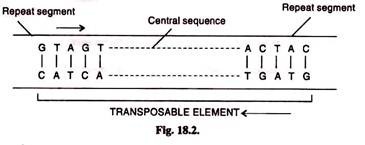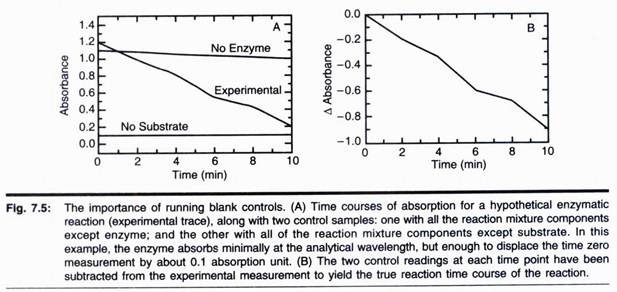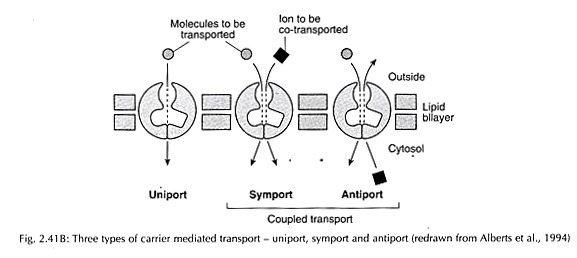ADVERTISEMENTS:
Let us make an in-depth study of the transposons or jumping genes. After reading this article you will learn about: 1. Introduction to Transposons 2. Types of Transposons 3. Structure of a Transposon 4. Target Sequence 5. Mechanism of Transposition 6. Functions of Transposons 7. Formation of New Genes and 8. Pseudogenes.
Introduction to Transposons:
Earlier it was thought that genes were static and had definite and fixed locus. However, several types of gene rearrangement and recombination have come to light recently. Segments of DNA that can jump to target sites in the genome were first discovered by Barbara Mc Clintock. She discovered that Indian maize corn have cobs with kernels of different colours.
According to her, the light coloured kernels were caused by a segment of DNA that jumped into the genes coding the pigmented kernels, thus inactivating the pigmented kernels. These mobile genes are called transposons or transposable elements.
ADVERTISEMENTS:
Transposons can jump within the genome thus affecting the expression of genes. They are quite different from the reciprocal or homologous exchanges of DNA. The movement of DNA segments is called transposition.
It is a specific form of genetic recombination that causes movement of certain genetic elements from one DNA site to another. Transposons inserted within a gene lead to disruption of their function. When they are inserted within the regulatory sequence of genes, they cause change in gene expression.
Transposons are present in all life forms. They are the main components of the moderately repetitive DNA. In human beings more than 50% genome is composed of transposable elements.
Types of Transposons:
Transposition occurs by two methods:
ADVERTISEMENTS:
1. Simple non-replicative transposition:
It involves excision of the transposon from its original location to the new DNA site. This is also known cut-and-paste transposition.
2. DNA transposition by replicative mechanism:
Transposable segments generate a new copy by replication. The first copy remains at the original site and second copy moves to a new site anywhere with in the genome.
The movement to the target site requires breaking up of the chromosome at the new site and inserting the transposon between the two ends generated. The enzymes required for breaking and re-joining the chromosome are present in the transposon itself.
Structure of a Transposon:
ADVERTISEMENTS:
Transposons are stretches of DNA that have repeated DNA segments at either end. A transposon consists of a central sequence that has transposes gene and additional genes. This is flanked on both sides by short repeated DNA segments. The repeated segments may be direct repeats or inverted repeats. These terminal repeats help in identifying transposons.
The number of repeated nucleotides is uneven 5 or 7 or 9 nucleotides are due to its method of insertion at the target site.
Target Sequence:
The site where a transposon is inserted is called target site or recipient site. Before the transposon is moved into the target site, the target sequence is duplicated.
ADVERTISEMENTS:
The two copies formed move apart. The transposon is inserted in between the two copies of the target sequences.
Mechanism of Transposition:
The enzyme transposase present in the transposon itself makes nicks or cuts in each strand of the target sequence. The target sequence is duplicated and two copies move away to make way for the transposon in the centre. The transposon then fixes itself into the two free ends generated. The nicks are sealed by ligase and two strands become continuous.
Functions of Transposons:
Mutation Caused by Transposons:
ADVERTISEMENTS:
Transposons are inserted within genes affecting their function, thus cause disruption of their functions. When they are inserted within the regulatory sequence of genes, they cause change in their expression. They are most common source of mutation. Transposons may insert stop codons thus producing truncated proteins.
In drosophilla, majority of spontaneous mutations are caused by transposons jumping into a gene. The mutant white-eyed drosphilla is produced by a transposable element inserted into the gene, which normally produces red pigment.
In human beings, transposons cause many genetic diseases. Transposons lead to the development of functional immune system in vertebrates.
ADVERTISEMENTS:
In bacteria, the transposable elements are present on extra chromosomal DNA called plasmid. Transposable elements on plasmids carry genes for proteins that nullify the effects of antibacterial drugs and toxins.
Formation of New Genes:
How do cells make new genes? Often it is done by exon shuffling by which the functional units of two existing genes recombine generating a new gene. Exon duplication and divergence also play their role in formation of new genes.
Pseudogenes:
Transposons introduce great genome flexibility. Sometimes duplicated genes and other transposons do not succeed in making a functional gene and therefore they become
Transposons or Jumping Genes:
preudogens or dead by products of evolution. The pseudogenes are frequent in mammalian genome and they are unable to produce mRNA for translation.




